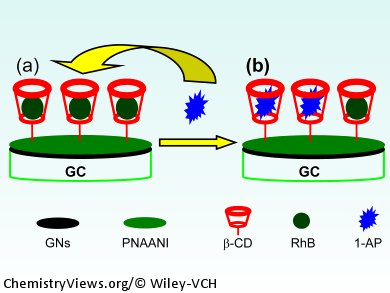The determination of organic pollutants can now be realized with a new dual-signalling electrochemical sensor. The sensor, a β-cyclodextrin (β-CD)/poly(N-acetylaniline)/electrogenerated-graphene film on a modified glassy carbon electrode, has been developed by Jinhua Chen and his team at the State Key Laboratory of Chemo/Biosensing and Chemometrics at Hunan University, China.
Host–guest interactions allow the probe molecule rhodamine B (RhB) to enter into the hydrophobic inner cavity of β-CD. The resulting signal from the glassy carbon electrode displays a remarkable oxidation peak due to RhB. In the presence of 1-aminopyrene (1-AP), competitive association to β-CD occurs and the RhB molecules are displaced by 1-AP. This results in a decreased oxidation peak current of RhB and the appearance of an oxidation peak current for 1-AP. The changes of these signals correlate linearly with the concentration of 1-AP.
The dual-signalling electrochemical sensing strategy is much more sensitive than the previously reported single-signalling electrochemical sensor and has promising applications for the sensitive and selective electrochemical determination of electroactive organic pollutants.
- A New Dual-Signalling Electrochemical Sensing Strategy Based on Competitive Host–Guest Interaction of β-Cyclodextrin/Poly(N-acetylaniline)/Graphene-Modified Electrode: Sensitive Electrochemical Determination of Organic Pollutants,
G. Zhu, L. Wu, X. Zhang, W. Liu, X. Zhang, J. Chen,
Chem. Eur. J. 2013.
DOI: 10.1002/chem.201204635



